2010 was a very memorable year for me in many ways. Perhaps one of the most important events of my year occurred on 1st of January 2010. That was the day I was unfortunate (and careless) enough to join a small group that nobody really wants to be a part of. On the 1st of January 2010, at approximately 6 p.m., I had the dubious honour of stepping on a stonefish. Clearly, I lived to tell the tale.
Yes, I've finally found the time to sit down and write a recount of my experience.

It started out normally, well, as normal as my life can be. A group of us made a trip to Beting Bemban Besar to help Mei Lin for her study on giant clams. It was raining quite heavily when we landed, but the rain soon cleared up and we began to explore the reef flat.
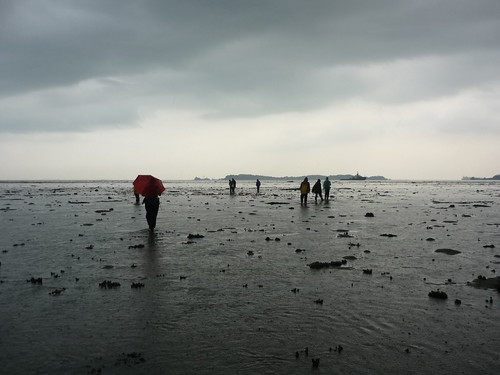

Of course, it being the 1st shore trip of the year, we even celebrated with a bottle of sparkling champagne.
(Photo by Kok Sheng)
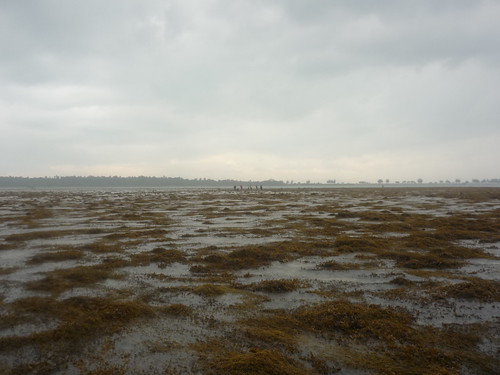
As is common for this time of year, there was extremely lush growth of sargassum seaweeds (Sargassum sp.).
For many of us shore explorers, sargassum is an annoyance. It is the largest of our local seaweeds, and grows in the form of long fronds, which due to the presence of tiny air-filled bladders, float on the surface. Hence sargassum is most commonly encountered in the form of dense mats that block one's view, making it impossible to see what is in the water or on the seabed. The water may be crystal clear, but with a sargassum bloom, you might as well be blind.

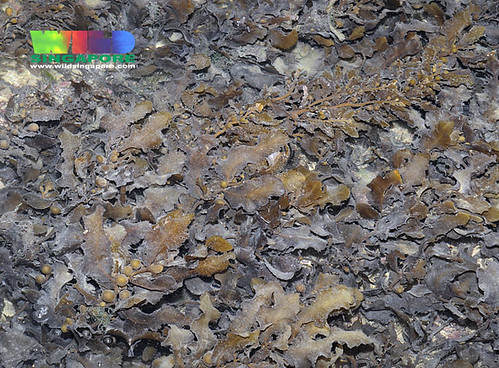
Imagine walking right through THAT.
(Photos by Ria)
Blundering into a thicket of sargassum might mean that one is inadvertently trampling on fragile and sensitive corals and sponges. Whatever marine life there is to find is completely hidden from view. While this in itself is frustrating, there is a grim twist, in that one also misses potentially dangerous organisms underfoot.
I was all too aware of the risks as I made my way through the patches of sargassum. Gingerly feeling my way and inching forward with my feet, the thought of stepping on a stingray or stonefish was something that was very much on my mind, and I recalled the tale of Chay Hoon's encounter with a stingray on Beting Bronok, or Ria's own stingray incident on Pulau Sekudu. As far as stonefish was concerned, we were all too familiar with what happened to Robin on Pulau Hantu in 2004, not to mention that even more recently, Luan Keng had to be sent to the hospital after she stepped on a stonefish on St. John's Island.
What are stonefish?

Trust me, this is the stonefish with the worst camouflage I have ever seen.
(Photo by Ria) (Raffles Lighthouse)
Found in coastal regions of the Indo-Pacific, stonefishes are predatory fish adapted for living on the seabed. They belong to the family Synanceiidae, and are armed with venomous spines. More on those spines later.
There are 5 known species of stonefish. Here in Singapore, the species we encounter on our shores is the hollow-cheeked stonefish (Synanceia horrida). It is widespread and not uncommonly encountered on reef flats, coral rubble, and rocky areas with sandy substrate. It is known to reach lengths of 30 centimetres, although most of the specimens we encounter on our intertidal trips are somewhat smaller.

This one is still quite easy to see.
(Photo by Ria) (Tanah Merah)
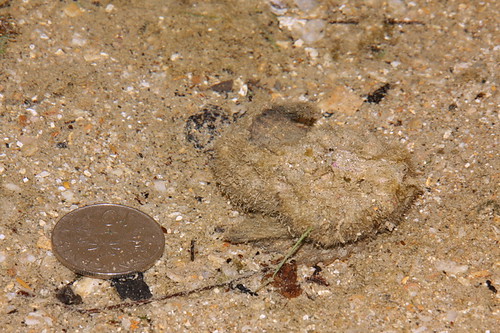
Aww so cute...
(Photo by James) (Big Sister Island)
Another species, the reef stonefish (Synanceia verrucosa) has been recorded from Singapore, but has yet to be encountered on our intertidal trips. This species is often seen by divers in many parts of the Indo-Pacific. In this post, unless stated otherwise, all mentions of stonefish on our shores will refer to the hollow-cheeked stonefish.
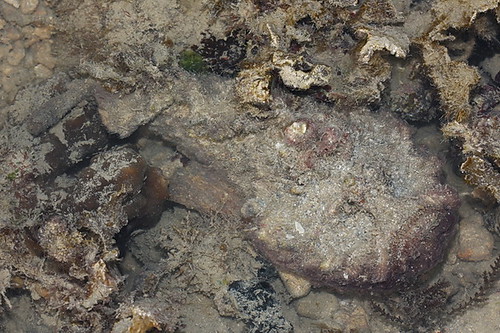
Stonefish seem to be perpetually frowning.
(Photo by James) (Pulau Semakau)
A poor swimmer, the stonefish lives on the seabed. It lacks scales, and instead, wart-like growths protrude from its skin, making it look very much like a rock. With its upturned mouth and eyes placed high on its head, it is adapted to sit on the bottom, watching.

Truly a face only its mother could love.
(Photo by Ria) (Tanah Merah)
Try to find the stonefish in this video taken by Andy at Tanah Merah.
Stonefish @ Tanah Merah 13Feb2010
The epitome of a sit-and-wait predator, the stonefish stays completely still and waits for unsuspecting prey (such as smaller fishes, crabs, and shrimps) to wander too close, whereupon it opens its huge maw and practically inhales its victim.
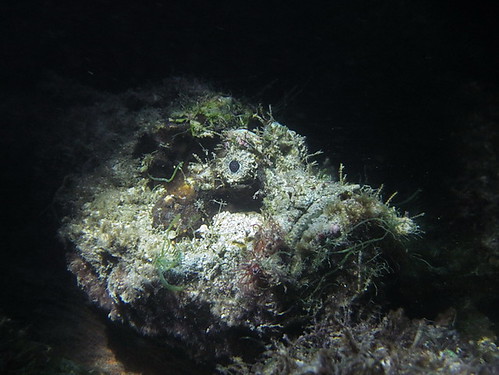
You can see the upturned mouth, and how the eyes are placed high up on the head.
(Photo by James) (St. John's Island)
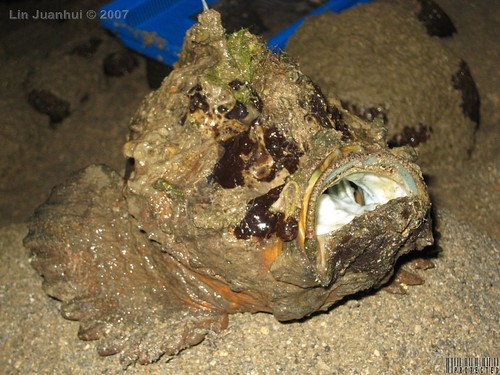
Open wide and say ahhh.
(Photo by Jun) (Kusu Island)
Here's a video clip that has been slowed down by several times, showing how the stonefish sucks in its prey.
And here's a video of 3 reef stonefish in an aquarium being fed.
In many cases, the stonefish itself is encrusted with a thick growth of algae, thus further improving its camouflage, making it all but invisible to prey and people alike.

Fuzzy, but definitely not for hugging.
(Photo by Ria) (Tanah Merah)
You can see how this stonefish that Andy filmed on St. John's Island is covered in bits of algae.
Stonefish-ed almost @ St John's Island 15May2010

Where's Wally? - the stonefish edition
(Photo by Ria) (Tanah Merah)

Try to make head or tail of this stonefish.
(Photo by Ria) (Pulau Hantu)
It is even capable of burying itself in the sand, leaving only its eyes, mouth, and the tips of the spines on its dorsal fin exposed.

That's not really what I meant by being fully buried.
(Photo by Ria) (Tanah Merah)

THIS is what I meant by buried. Yes. This is a stonefish.
(Photo by Ria) (Tanah Merah)
********************
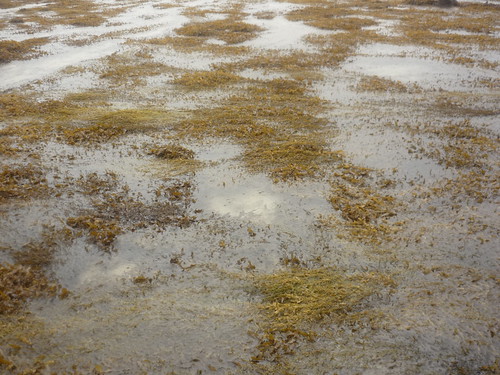
Now, imagine trying to walk through that while keeping an eye out for stonefish.
Things seemed to be going fine as usual; I tried my best to be careful, and kept my eyes open. I was trying to make my way from one bare patch of coral rubble that was free of sargassum to another, much like how one hops from one rock to another in a river. However, I clearly wasn't alert enough; as I walked through one of these bare patches, I felt a sudden sharp pricking right smack in the middle of the sole of my left foot, and I literally jumped.
I recall cursing under my breath, it did feel as if I had stepped on something very sharp. I hobbled to one side and examined the sole of my diving bootie. I saw a slight ragged tear in the rubber. I decided to remove my bootie, and looked carefully at my foot. I saw a couple of small holes in my sole, but there was no bleeding at all.
I wasn't sure if I was imagining things, but I was feeling an odd tingling sensation in my foot, and it wasn't a good sign. I've had my fair share of mishaps while out on the seashore; whether it's getting pinched by crabs, nearly slipping while walking amongst rocks, or underestimating the stinging power of fireworms (Chloeia sp.), I would consider myself to be somewhat adventurous, but not to the point of being reckless and suicidal.
I couldn't help but wonder if I'd been nailed by a stonefish. All of us who explore Singapore's shores are aware of the risk of stonefish, and we have encountered them from time to time, but somehow, I never really thought that I would get stung by one. I put my bootie back on and looked carefully at the area I had just walked on.
And there it was. There was no mistaking the fact that there was a hollow-cheeked stonefish, about 15 centimetres long, sitting there amongst the rubble. I saw how the skin of the first spine of its dorsal fin had been pulled back, exposing the venom-loaded tip. This suggested that the spine had just been put into action.
Why are stonefish so dangerous?
We have seen how the stonefish makes use of its excellent camouflage to conceal itself. Once it has found a suitable location, it can be incredibly patient, staying in the same spot for days. Even if the tide goes out, stonefish can remain alive out of water for several hours, waiting for the water to return. Hence at low tide, stonefish can be found in extremely shallow water, or even fully exposed on land. This, plus its habit of living in coastal waters, makes it easy for people to come into contact with stonefish. Hence, its cryptic appearance and habitat preferences mean that there is always some level of risk of unknowingly stepping on a stonefish if one is not careful or alert.
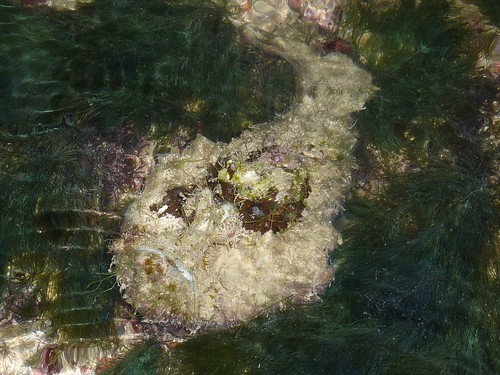
This is why you should always look carefully where you are about to place your foot.
(Photo by Kok Sheng) (St. John's Island)
Although the stonefish is a predator, it too is at risk of falling prey to larger predators. Stonefish have been recorded from the stomach contents of sharks, and Stokes' seasnake (Astrotia stokesii) has also been recorded to prey upon stonefish.
The stonefish's chief form of defence comes from the 13 sharp spines on its dorsal fin. Each spine is usually sheathed in skin and laid flat along the fish's back. However, should a large shadow be cast upon the stonefish, these spines are raised, primed and ready for action.

Some of the dorsal fin spines on a stonefish.
(Photo by Ria) (Tanah Merah)
Each spine bears a groove running up each side, and each groove is attached to a venom gland. When pressure is applied to the tip of the spine, such as when a person steps on the stonefish, the skin covering the spine is pulled back, and as the spine penetrates the threat, venom is injected from the glands right into the wound.

Exposed spines of reef stonefish
(Photo by Island-Life)
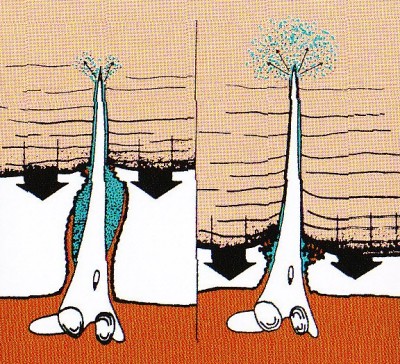
Illustration showing how venom is injected by a stonefish spine.
(Scanned from Dangerous Marine Animals)
The venom is pale blue, and is composed of various proteins. One of these toxins extracted from the hollow-cheeked stonefish, called stonustoxin, is a neurotoxin that damages nerve cells, and is also cytolytic, killing cells due to osmotic imbalance. Stonustoxin also causes a rapid drop in blood pressure, which can be life-threatening in certain circumstances. Like many other venomous animals, stonefish possess some potential in pharmaceutical research and development, but all this is lost on someone who is on the receiving end of its venomous spines.
The stonefish also possesses similar but smaller spines on its underside; 3 spines on its anal fin, and a pair of pelvic spines.
With such potentially deadly weapons, the stonefish does not retreat when a potential threat approaches. It stays put, and only when contact is imminent does it raise its dorsal fin spines. Should you step on one, your full weight drives the spines deep into your foot, resulting in the injection of a full load of venom. And remember, that there are 13 spines on the stonefish's back. And as I experienced firsthand, the spines are sharp and long enough to penetrate even the soles of rubber booties and flippers. Imagine how much worse it must be for someone who is barefoot.
According to Dangerous Marine Animals:
The immediate effect of a stonefish envenomation is severe burning pain, which can last for days. Swelling at the puncture site usually spreads extensively. Blisters may develop around it and small patches of tissue may die off. Further symptoms are nausea, vomiting and diarrhea, as well as respiratory problems that can cause fainting. Although cases of envenomation leading to death within a few hours have been reported, this is rare."
These video clips describe in great detail how the stonefish defends itself with its venomous spines, and also show how hard it can be to spot a stonefish in its natural habitat.
Because of its potent venom, the various species of stonefish are said to be among the most venomous fishes in the world.

Seriously, this is why people who visit the shores need to have sharp eyesight and attention to detail.
(Photo by Ria) (Tanah Merah)
********************
I remember saying to myself, "Oh fuck." A part of me was in denial, trying to convince myself that I'd stepped on a sharp rock, and that this stonefish had nothing to do with the odd tingling and weakness that I was becoming quite acutely aware of in my left foot. Still, it was becoming quite clear that whether I had been stung by a stonefish or not, it would be a good idea to find the rest of my friends, just in case I suddenly went into cardiac arrest or something.
For a moment, I contemplated taking out my camera and snapping a photo of the stonefish, but for some reason, I was afraid that I might lose my balance and drop my camera, or that I was wasting precious seconds in seeking immediate medical attention. And so, I turned around and limped along as quickly as I could, towards my friends. Now I regret not taking at least 1 or 2 photos of that stonefish.

It did however look a lot like this.
(Photo by Ria) (Tanah Merah)
This was actually the 3rd time I had encountered a stonefish on our shores; the 1st time was in 2006, when I found a youngster about 7 or 8 centimetres long, on one of the islets across from Siloso Beach in Sentosa.
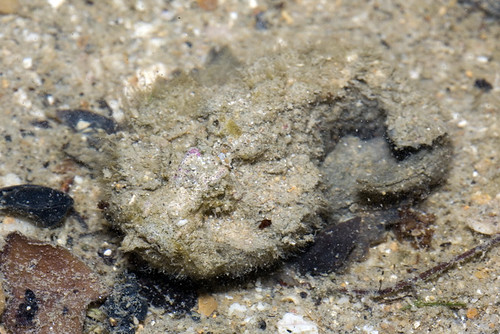
No photos, but it looked a lot like this one, except it was very dark brown.
(Photo by Marcus) (Big Sister Island)
I was looking for marine life on the shore when I came upon this oddly shaped lump close to the water's edge. My fingers brushed against it for a moment, and I was shocked when I took a good long look at the lump and realised that it was a small stonefish! I assumed that it was dead and went off to look elsewhere. A while later, I returned to the spot, only to observe that the stonefish's gills were still moving, even though it was on dry land. With a twig, I flicked it into the water, and it slowly swam off into the murky depths. After that, I gave the area a wide berth.
My second encounter with a stonefish was on Cyrene Reef in May 2008; we had found an old disused fish trap, with a large stonefish around 20 centimetres long, parked right in the middle of the trap.
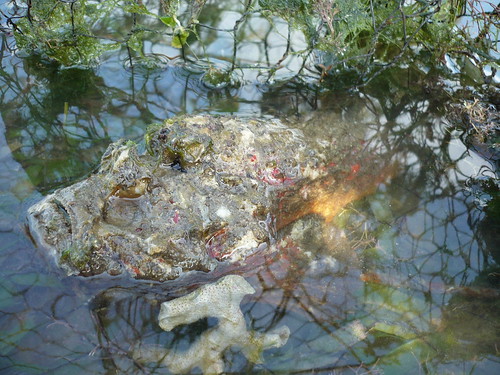
While the tide was going down, it appeared content to remain where it was, and we definitely weren't going to move it. I took several photos, at times so close that I could have reached out a finger to gently prod it if I'd wanted to. We made sure that the hole in the trap was large enough for the stonefish to swim out and escape if it chose to, and left it there.
I guess the 3rd time wasn't a charm, after all.
Coincidentally, I had just finished reading The Snake Charmer: A Life and Death in Pursuit of Knowledge, about a young herpetologist who specialised in venomous snakes, and who met his death after a moment of carelessness caused him to get bitten by a many-banded krait (Bungarus multicinctus) in a village in Myanmar far from medical help. It certainly was not very reassuring to be reminded of that when I had just been envenomated by the world's most venomous fish. I was feeling an extremely odd tingling sensation in my foot, which was slowly spreading up towards my ankle. I reminded myself to take deep breaths and not panic, while I slowly made my way across the reef flat towards where the others were, still unaware of my mishap. Being morbid as usual (even in the face of my own misfortune), I was wondering how macabre and unfortunate it would be if I stepped on another stonefish while on my way to seek help.
After about 10 minutes or so of hobbling, I reached the others. Andy was nearest to me, so I waved my arms and hollered.
"Andy, stonefish!"
He looked up at me, and asked, "Where?"
"No, I just stepped on one!"
I remember how the look on his face changed in an instant, and he came over to help support me in case my leg gave way. Later on, he told me that he was initially excited as he thought that I had found a stonefish for him to film, only to be confronted by the revelation that the stonefish was far away, and that I had been foolish enough to get stung by it.
We were all supposed to be making our way back to the boat by this time anyway, so I hobbled along, supported by Andy, while James walked ahead and made sure that we had a clear path free of seaweed and other stonefish.

That's me limping back to the boat while Andy provides support in case my leg decides to fail along the way.
(Photo by Kok Sheng)
We made it back to the boat about half an hour after I had been stung, and after I clambered aboard, I took my bootie off immediately. That was when I realised that it had been acting as a tourniquet all along, slowing the spread of the venom up my leg. The tingling sensation practically shot up my lower leg, which was noticeably swelling up, and in seconds, this sensation was hovering at my shin, just below my kneecap. Imagine getting pins and needles after your leg falls asleep, but mixed with a dull throbbing aching in your foot and ankle.

While the rest prepared some emergency treatment, I made phone calls to my then girlfriend and my sister, telling them what had happened and not to worry. I remember emphasising that I would live and I was going to be fine. It always helps to be confident and optimistic about your odds of survival. Sometimes you just need to stay calm and be confident that everything is going to be alright.
(Photo by Kok Sheng)
And of course, being the social media addict, I had to tweet about it:
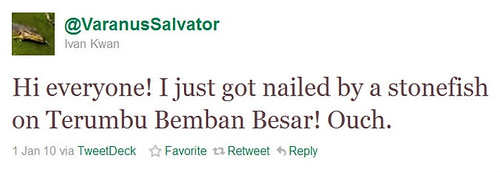
Apologies for the naming error; at that time I still had my terumbu and beting mixed up.
The dustbin was turned into a washbasin, and filled up with hot water from the thermos flask on board. Apparently, heat denatures the proteins that make up the venom and reduces their effects to some degree.

(Photo by Ria)
It was so scalding hot that some cold water had to be poured in before I could comfortably soak my foot. And it did provide a great deal of relief; the hot water numbed some of the pain, and things were quiet for a while, as the boat sped back towards mainland Singapore.

However, the water soon cooled, and that was when the pain truly returned with a vengeance. Like I tell everyone who asks me what it feels like, imagine a horrible throbbing cramp in your leg, your most painful cramp ever. You can feel it travelling up your leg, towards your kneecap, and just when you think it could not be more painful, you feel a red-hot needle being pushed right into your foot, and this stabbing pain is shooting up towards your kneecap as well.
That's the best detail I can use to describe the crippling agony. In other words, it's goddamn fucking painful.
Here's an account from someone unfortunate enough to get stung by a stonefish on the finger:
"I got spiked on the finger by a stonefish in Australia... never mind a bee sting... Imagine having each knuckle, then the wrist, elbow and shoulder being hit in turn with a sledgehammer over the course of about an hour. Then about an hour later imagine taking a real kicking to both kidneys for about 45 minutes so that you couldn't stand or straighten up. I was late 20s, pretty fit physically and this was the tiniest of nicks. Got sensation back in my finger after a few days but had recurrent kidney pains periodically for several years afterwards."
In my case, the pain soon became quite unbearable, and I asked the rest if they minded if I started screaming and cursing. Andy has video footage of me in one of my outbursts, yelling out a string of swear words.
Here's a funny stand-up comedy clip about the stonefish. WARNING: Adult language. But I can definitely identify with Billy Connolly's impression of someone's expression of pain after stepping on a stonefish.

It seemed like almost forever before we finally returned to the Marina at Keppel Bay, and we managed to get a buggy to bring me out to the lobby area. Andy went to fetch his car, with James and Marcus accompanying me. Based on previous experiences with dealing in stings by venomous creatures, the decision was made to drive down to Tan Tock Seng Hospital.

Traffic was smooth, but of course, given the pain I was in at that time, I wished we could have reached there in an instant. On the way, in an attempt to take my mind off the pain, I was reciting all the Latin names of whatever animals I could think of.

For what happened after I arrived at the hospital, the recovery, and my thoughts a year after the incident, all will be told in my next post.